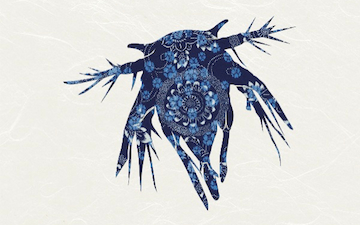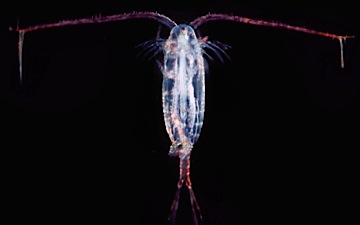Copepods (![]() /ˈkoʊpɪpɒd/; meaning “oar-feet”) are a group of small crustaceans found in the sea and nearly every freshwater habitat. Some species are planktonic (drifting in sea waters), some are benthic (living on the ocean floor), and some continental species may live in limno-terrestrial habitats and other wet terrestrial places, such as swamps, under leaf fall in wet forests, bogs, springs, ephemeral ponds and puddles, damp moss, or water-filled recesses (phytotelmata) of plants such as bromeliads and pitcher plants. Many live underground in marine and freshwater caves, sinkholes, or stream beds. Copepods are sometimes used as bioindicators (see particle (ecology)).
/ˈkoʊpɪpɒd/; meaning “oar-feet”) are a group of small crustaceans found in the sea and nearly every freshwater habitat. Some species are planktonic (drifting in sea waters), some are benthic (living on the ocean floor), and some continental species may live in limno-terrestrial habitats and other wet terrestrial places, such as swamps, under leaf fall in wet forests, bogs, springs, ephemeral ponds and puddles, damp moss, or water-filled recesses (phytotelmata) of plants such as bromeliads and pitcher plants. Many live underground in marine and freshwater caves, sinkholes, or stream beds. Copepods are sometimes used as bioindicators (see particle (ecology)).
Copepods are typically 1 to 2 millimetres (0.04 to 0.08 in) long, with a teardrop shaped body and large antennae. Although like other crustaceans they have an armoured exoskeleton, they are so small that in most species this thin armour, and the entire body, is almost totally transparent. Some polar copepods reach 1 centimetre (0.39 in). Copepods have a compound, median single eye, usually bright red and in the centre of the transparent head; subterranean species may be eyeless. Like other crustaceans, copepods possess two pairs of antennae; the first pair are often long and conspicuous.
Copepods typically have a short, cylindrical body, with a rounded or beaked head. The head is fused with the first one or two thoracid segments, while the remainder of the thorax has from three to five segments, each with limbs. The first pair of thoracic appendages are modified to form maxillipeds, which assist in feeding. The abdomen is typically narrower than the thorax, and contains five segments without any appendages, except for some tail-like “rami” at the tip.[5]
Because of their small size, copepods have no need of any heart or circulatory system (the members of the order Calanoida have a heart but no blood vessels), and most also lack gills, being able to absorb oxygen directly into their bodies. Their excretory system consists of maxillary glands.
The second pair of antennae are the main source of propulsion, beating like oars to pull the animal through the water.
Many of the smaller copepods feed directly on phytoplankton, catching cells singly. Some of the larger species are predators of their smaller relatives. Many benthic copepods eat organic detritus or the bacteria that grow in it, and their mouth parts are adapted for scraping and biting. Herbivorous copepods, particularly those in rich cold seas, store up energy from their food as oil droplets while they feed in the spring and summer plankton blooms. These droplets may take up over half of the volume of the body in polar species.
Some copepods have extremely fast escape responses when a predator is sensed and can jump with high speed over a few millimeters. Many species have neurons surrounded by myelin (for increased conduction speed), which is very rare among invertebrates (other examples are some annelids and malacostracan crustaceans like palaemonid shrimp and penaeids). Even rarer, the myelin is highly organized, resembling the well-organized wrapping found in vertebrates (Gnathostomata).
Finding a mate in the three-dimensional space of open water is challenging. In some copepods the problem is solved by pheromone chemicals emitted by the swimming female, which leaves a trail in the water that the male can follow to locate the female.[6]
(From Wikipedia, 27 August 2011)





